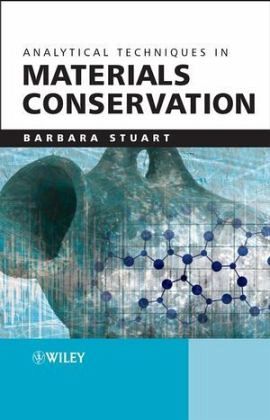Nicht lieferbar

Analytical Techniques in Materials Conservation
This book introduces the reader to the wide variety of analytical techniques that are employed by those working on the conservation of materials. An introduction to each technique is provided with explanations of how data may be obtained and interpreted. Examples and case studies are included to illustrate how each technique is used in practice.
The use of scientific techniques in materials conservation has expanded considerably in recent decades and there is a great deal of interest in identifying the materials used in culturally important objects. Of importance is a clear understanding of the state and mechanisms of degradation of objects. Of importance is a clear understanding of the state and mechanisms of degradation of objects susceptible to deterioration with time and exposure to environmental factors. In addition, awareness of the state of materials at a molecular level can provide valuable information for conservators, enabling them to decide on a conservation procedure.
This book presents the extensive range of analytical techniques used by scientists that may be applied to heritage materials such as paintings, metals, sculptures, written material, natural materials, synthetic polymers, textiles, tone, ceramics and glass.
An introductory chapter describes the types and chemistry of materials encountered in conservation. Chapters 2 to 10 provide a straightforward background to each of the common analytical techniques:
_ Basic identification techniques
_ Light examination and microscopy
_ Molecular spectroscopy
_ Atomic spectroscopy
_ X-ray techniques
_ Mass spectrometry
_ Chromatography and electrophoresis
_ Thermal and mechanical analysis
_ Nuclear methods
An explanation of how an instrument works is provided without the excessive technical detail that can be overwhelming for the first-time user. The nature and size of a sample required for each technique is given as this is an important consideration in conservation. Additionally, for each technique, examples of the application of the method to specific types of heritage materials are provided, with the relevant literature references.
This book will be a useful source of information for those with an interest in materials conservation. While it should prove an aid to those already working in this field, the book is also aimed at those entering the field who would like to know more about the analysis of heritage materials. An in-depth knowledge of chemistry, materials science or analytical chemistry is no assumed, so those without a strong background in these fields will be able to understand the scientific concepts presented.
This book presents the extensive range of analytical techniques used by scientists that may be applied to heritage materials such as paintings, metals, sculptures, written material, natural materials, synthetic polymers, textiles, tone, ceramics and glass.
An introductory chapter describes the types and chemistry of materials encountered in conservation. Chapters 2 to 10 provide a straightforward background to each of the common analytical techniques:
_ Basic identification techniques
_ Light examination and microscopy
_ Molecular spectroscopy
_ Atomic spectroscopy
_ X-ray techniques
_ Mass spectrometry
_ Chromatography and electrophoresis
_ Thermal and mechanical analysis
_ Nuclear methods
An explanation of how an instrument works is provided without the excessive technical detail that can be overwhelming for the first-time user. The nature and size of a sample required for each technique is given as this is an important consideration in conservation. Additionally, for each technique, examples of the application of the method to specific types of heritage materials are provided, with the relevant literature references.
This book will be a useful source of information for those with an interest in materials conservation. While it should prove an aid to those already working in this field, the book is also aimed at those entering the field who would like to know more about the analysis of heritage materials. An in-depth knowledge of chemistry, materials science or analytical chemistry is no assumed, so those without a strong background in these fields will be able to understand the scientific concepts presented.



